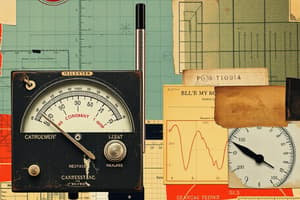Podcast
Questions and Answers
What does acceptable staking adhesive look like for Class 1 components?
What does acceptable staking adhesive look like for Class 1 components?
- Adhesive material is visible in the termination area, but joint width meets minimum requirements (correct)
- Adhesive is completely cured and homogemous
- Adhesive extends from under the component in all areas
- Adhesive material is not visible in the termination area
Adhesive materials extending from under the component are visible in the termination area for a Class 3 defect.
Adhesive materials extending from under the component are visible in the termination area for a Class 3 defect.
True (A)
What is the minimum percentage of component height that adhesive must adhere to for round components in Class 1, 2, and 3?
What is the minimum percentage of component height that adhesive must adhere to for round components in Class 1, 2, and 3?
25%
What is considered a defect for staking adhesive on round components?
What is considered a defect for staking adhesive on round components?
What happens when solder touches a plastic component body during SMT?
What happens when solder touches a plastic component body during SMT?
A lead that is damaged more than 10% of its diameter is categorized as a Class 1 defect.
A lead that is damaged more than 10% of its diameter is categorized as a Class 1 defect.
What is the acceptable thickness of a flattened lead for Class 1 and 2 components?
What is the acceptable thickness of a flattened lead for Class 1 and 2 components?
What is the minimum end joint width required for Class 3 components?
What is the minimum end joint width required for Class 3 components?
What is the acceptable side joint length for rectangular or square end chip components?
What is the acceptable side joint length for rectangular or square end chip components?
What is the acceptable maximum fillet height (E) for Rectangular or Square End Chip Components?
What is the acceptable maximum fillet height (E) for Rectangular or Square End Chip Components?
What does minimum fillet height (F) exhibit on the vertical surface(s) of the component termination?
What does minimum fillet height (F) exhibit on the vertical surface(s) of the component termination?
What does minimum fillet height (F) consist of for Class 3?
What does minimum fillet height (F) consist of for Class 3?
What is the requirement for wetted fillet in terms of solder thickness?
What is the requirement for wetted fillet in terms of solder thickness?
End overlap (J) must always be 25% or more between the component termination and the land.
End overlap (J) must always be 25% or more between the component termination and the land.
What should the width (W) to height (H) ratio not exceed for mounting on the side?
What should the width (W) to height (H) ratio not exceed for mounting on the side?
For components larger than size 1206, how many termination faces should they have?
For components larger than size 1206, how many termination faces should they have?
Center terminations must have a minimum side termination width of 50% of the component termination width.
Center terminations must have a minimum side termination width of 50% of the component termination width.
What is the acceptable value for side overhang (A) of cylindrical end cap terminations?
What is the acceptable value for side overhang (A) of cylindrical end cap terminations?
What is the defect related to the end overhang (B) in cylindrical end cap terminations?
What is the defect related to the end overhang (B) in cylindrical end cap terminations?
What should be evident for the minimum heel fillet height (E) in case of a toe-down configuration?
What should be evident for the minimum heel fillet height (E) in case of a toe-down configuration?
Surface mount area array solder connections should not make contact with the land.
Surface mount area array solder connections should not make contact with the land.
What type of overhang is unacceptable for P-Style connections?
What type of overhang is unacceptable for P-Style connections?
What aspect of flat gull wing leads is considered a defect?
What aspect of flat gull wing leads is considered a defect?
Flashcards
Staking Adhesive Acceptability
Staking Adhesive Acceptability
Class 1: Adhesive visible, end joint width meets minimums. Class 3: Adhesive visible, criteria not met.
Adhesive for Round Components
Adhesive for Round Components
Minimum of 3 beads evenly placed, covering ≥ 25% of component height.
SMT Lead Damage Limit
SMT Lead Damage Limit
Leads should not have damage or deformation exceeding 10% of diameter/width/thickness.
Chip Component Side Overhang (Class 1/2)
Chip Component Side Overhang (Class 1/2)
Signup and view all the flashcards
Chip Component End Joint Width (Class 1/2)
Chip Component End Joint Width (Class 1/2)
Signup and view all the flashcards
End Joint Width (Class 3)
End Joint Width (Class 3)
Signup and view all the flashcards
Cylindrical End Cap Overhang
Cylindrical End Cap Overhang
Signup and view all the flashcards
Castellated Terminations Overhang (Class 1/2)
Castellated Terminations Overhang (Class 1/2)
Signup and view all the flashcards
Castellated End Joint Width (Class 3)
Castellated End Joint Width (Class 3)
Signup and view all the flashcards
Flat Gull Wing Overhang (Class 1/2)
Flat Gull Wing Overhang (Class 1/2)
Signup and view all the flashcards
Flat Gull Wing End Joint (Class 3)
Flat Gull Wing End Joint (Class 3)
Signup and view all the flashcards
J-Leads Toe Overhang
J-Leads Toe Overhang
Signup and view all the flashcards
BGA Solder Connections
BGA Solder Connections
Signup and view all the flashcards
Gull Wing Heel Fillet Height
Gull Wing Heel Fillet Height
Signup and view all the flashcards
Cylindrical End Overlap
Cylindrical End Overlap
Signup and view all the flashcards
Maximum Termination Overhang - Square Solder Land (Class 1)
Maximum Termination Overhang - Square Solder Land (Class 1)
Signup and view all the flashcards
Maximum Termination Overhang - Square Solder Land (Class 2)
Maximum Termination Overhang - Square Solder Land (Class 2)
Signup and view all the flashcards
Termination Overhang Defect - Round Solder Land (Class 1)
Termination Overhang Defect - Round Solder Land (Class 1)
Signup and view all the flashcards
Termination Overhang Defect - Round Solder Land (Class 2)
Termination Overhang Defect - Round Solder Land (Class 2)
Signup and view all the flashcards
P-Style Connections - Max Overhang (Class 1)
P-Style Connections - Max Overhang (Class 1)
Signup and view all the flashcards
P-Style Connections - Max Overhang (Class 2)
P-Style Connections - Max Overhang (Class 2)
Signup and view all the flashcards
SMT Jumper Wire Defect
SMT Jumper Wire Defect
Signup and view all the flashcards
Gull Wing Jump Wires
Gull Wing Jump Wires
Signup and view all the flashcards
Study Notes
Staking Adhesive - Component Bonding
- Acceptable (Class 1): Adhesive material visible in termination area, with end joint width meeting minimum requirements.
- Defect (Class 3): Adhesive material visible in termination area, not meeting acceptable criteria.
Staking Adhesive - Mechanical Strength
- Acceptable (Class 1, 2, 3): On round components, adhesive covers at least 25% of component height and requires a minimum of three beads evenly placed around the component.
- Defect (Class 1, 2, 3): Fewer than three beads of staking material on round components.
SMT Leads - Plastic Components
- Solder should not contact the package body or seal unless specific lead configurations cause contact with plastic components like SOIC family.
SMT Leads - Damage
- Defect (Class 1, 2, 3): Damage or deformation to leads exceeding 10% of their diameter, width, or thickness.
SMT Connections
- Components with non-wettable areas by design are exempt from solder wetting requirements in those regions.
Chip Components - Bottom Only Terminations
- Side Overhang (Class 1, 2): Side overhang must be ≤ 50% of component termination or land width.
- End Joint Width (Class 1, 2): Minimum width must be ≥ 50% of component termination or land width.
Rectangular or Square End Chip Components
- Acceptable Side Overhang (Class 1, 2): ≤ 50% of termination or land width.
- End Joint Width (Class 3): Minimum end joint width must be ≥ 75% of termination or land width.
Cylindrical End Cap Terminations
- Referred to as MELF (Metal Electrode Leadless Face).
- Acceptable Side Overhang (Class 1, 2, 3): Must be ≤ 25% of component width or land width.
Castellated Terminations
- Acceptable Side Overhang (Class 1, 2): Maximum ≤ 50% castellation width.
- Minimum End Joint Width (Class 3): Should be ≥ 75% of castellation width.
Flat Gull Wing Leads
- Side Overhang (Class 1, 2): Maximum overhang should not exceed 50% of lead width or 0.5 mm.
- Minimum End Joint Width (Class 3): Minimum end joint width should be ≥ 75% lead width.
J-Leads
- Toe Overhang (Class 1, 2, 3): This parameter is unspecified, offering flexibility in design.
Surface Mount Area Array
- Process guidance provided in IPC-7095 with a focus on addressing process development issues.
- Solder Connections (Class 1, 2, 3): BGA solder balls must contact and wet the land to form a complete connection.
Additional Notes on Fillets and Joints
- Minimum Heel Fillet Height (Flat Gull Wing): In toe-down configurations, minimum height should extend to at least the midpoint of outside lead bends.
- End Overlap (Cylindrical Terminations): Must be ≥ 50% the length of component termination for acceptable standards.
Familiarize with the criteria detailed above for various components to ensure compliance with IPC-A-610 standards across different classes.### Components with Bottom Thermal Plane Terminations
- Thermal plate terminations are characterized by their end joint width.
- Acceptable standards include Class 1, 2, and 3.
Flattened Post Connections
- Connections should comply with dimensional and solder fillet standards as per specific tables.
- Maximum termination overhang differs based on solder land shape and class.
Maximum Termination Overhang - Square Solder Land
- Class 1: Overhang must be less than 75%.
- Class 2: Overhang must be less than 50%.
Maximum Termination Overhang - Round Solder Land
- Class 1 defect: Overhang exceeds 50%.
- Class 2 defect: Overhang exceeds 25%.
Maximum Fillet Height
- Defect classifications for Class 1 and 2 occur when solder touches the package body.
P-Style Connections - Maximum Side Overhang
- Class 1: Acceptable overhang is equal to or less than 50% of the termination width.
- Class 2: Acceptable overhang is equal to or less than 25% of the termination width.
- Class 3 requires no side overhang.
P-Style Connections - Minimum Side Overhang
- Acceptable classifications for minimum side overhang are unspecified and marked as Class.
Surface Mount Connections
- Defects in Classes 1, 2, and 3 must meet form, fit, and function requirements, often necessitating trial mating for acceptance.
Jumper Wires
- Refer to IPC-7711/7721 for guidelines on rework and repair.
- Criteria for wire includes selection, routing, and adhesive staking relevant to SMT jumper wires.
General Conditions for Lap Solder Connections
- Key conditions include insulation clearance, no fractures, and specific wire contour standards, including wire overhang regulations.
Jump Wires - SMT - Chip and Cylindrical End Cap
- Acceptable in Classes 1, 2, and 3 if properly adhered.
- A defect occurs when the wire is soldered on top of the chip component termination.
Gull Wing Configuration
- Jump wires in this configuration are acceptable across all classes ensuring proper wire extends past the knee of the bend.
Studying That Suits You
Use AI to generate personalized quizzes and flashcards to suit your learning preferences.




